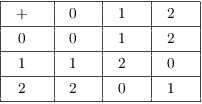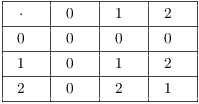Definiton. Let a, b, and m be integers. a is
congruent to b mod m if
![]() ; that is, if
; that is, if
![]()
Notation: ![]() means that a is congruent to b
mod m. m is called the modulus of the
congruence; I will almost always work with positive moduli.
means that a is congruent to b
mod m. m is called the modulus of the
congruence; I will almost always work with positive moduli.
Note that ![]() if and only if
if and only if ![]() . Thus, modular arithmetic gives you another way of
dealing with divisibility relations.
. Thus, modular arithmetic gives you another way of
dealing with divisibility relations.
For example:
![]() because
because ![]() .
.
![]() because
because ![]() .
.
Proposition. Congruence mod m is an equivalence relation:
(a) ( Reflexivity) ![]() for all a.
for all a.
(b) ( Symmetry) If ![]() , then
, then ![]() .
.
(c) ( Transitivity) If ![]() and
and ![]() , then
, then ![]() .
.
Proof. Since ![]() , it follows that
, it follows that ![]() .
.
Suppose ![]() . Then
. Then ![]() , so
, so ![]() . Hence,
. Hence, ![]() .
.
Suppose ![]() and
and ![]() . Then there are integers j and k such that
. Then there are integers j and k such that
![]()
Add the two equations:
![]()
This implies that ![]() .
.![]()
Example. (a) List the elements of the equivalence classes relative to congruence mod 3.
(b) Using 0, 1, and 2 to represent these equivalence classes, construct addition and multiplication tables mod 3.
(a) The equivalence classes are the 3 congruence classes:
![]()
Each integer belongs to exactly one of these classes. Two integers in a given class are congruent mod 3.
(If you know some group theory, you probably recognize this as
constructing ![]() from
from ![]() .)
.)![]()
(b)


For example, ![]() , because
, because ![]() as integers, and the congruence class of 3 is
represented by 0. Likewise,
as integers, and the congruence class of 3 is
represented by 0. Likewise, ![]() as integers,
and the congruence class of 4 is represented by 1.
as integers,
and the congruence class of 4 is represented by 1.![]()
I could have chosen different representatives for the classes --- say
3, -4, and 4. A choice of representatives, one from each class, is
called a complete system of residues mod 3.
But working mod 3 it's natural to use the numbers 0, 1, and 2 as
representatives --- and in general, if I'm working mod n, the obvious
choice of representatives is the set ![]() . This set is called the standard residue system mod n, and it is the set
of representatives I'll usually use. Thus, the standard residue
system mod 6 is
. This set is called the standard residue system mod n, and it is the set
of representatives I'll usually use. Thus, the standard residue
system mod 6 is ![]() .
.
Theorem. Suppose ![]() and
and ![]() . Then:
. Then:
(a) ![]() and
and ![]() .
.
(b) ![]() .
.
Proof. I'll prove the first congruence as an
example. Suppose ![]() and
and ![]() . Then
. Then ![]() and
and ![]() for some
for some ![]() , so
, so
![]()
This implies that ![]() .
.![]()
Example. Solve the congruence
![]()

There are no "fractions" mod 11. I want to divide by 3, and
to do this I need to multiply by the multiplicative inverse of 3. So
I need a number k such that ![]() .
A systematic way of finding such a number is to use the Extended Euclidean algorithm. In this case, I just
use trial and error. Obviously,
.
A systematic way of finding such a number is to use the Extended Euclidean algorithm. In this case, I just
use trial and error. Obviously, ![]() and
and ![]() won't work, so I'll start at
won't work, so I'll start at ![]() :
:
![]()
Thus, I need to multiply the equation by 4:

Definition. x and y are
multiplicative inverses mod n if ![]() .
.
Notation: ![]() or
or ![]() . Do not use fractions.
. Do not use fractions.
Example. (a) Find ![]() .
.
(b) Prove that 6 does not have a multiplicative inverse mod 8.
(a) ![]() , so
, so ![]() .
.![]()
(b) Suppose ![]() . Then
. Then

This contradiction shows that 6 does not have a multiplicative
inverse mod 8.![]()
Example. Reduce ![]() to a number in
to a number in
![]() .
.
![]()
Example. Reduce ![]() to a number in
to a number in ![]() .
.
![]() , so
, so
![]()
Example. Show that if p is prime, then
![]()
By the Binomial Theorem,
![]()
A typical coefficient ![]() is divisible by p for
is divisible by p for ![]() . So going mod p, the only terms that remain are
. So going mod p, the only terms that remain are ![]() and
and ![]() .
.
For example
![]()
The result is not true if the modulus is not prime. For example,
![]()
Copyright 2020 by Bruce Ikenaga